Tuesday Triage #95
- TUESDAY TRIAGE #95 by Vadim Drobinin
- On multiple attempts
- Things I enjoyed reading
- 1. How DALL-E 2 Actually Works by Ryan O'Connor
- 2. ‘It’s a head office for tinkering’: Jony Ive and Marc Newson talk tools by Nick Foulkes
- 3. ’Why Am I Not Rich & Famous?’ the Delusion of Our Times by Darius Foroux
- 4. How Well Can You Kaggle with Just One Hour a Day? by @DSaience
- 5. What Dinner Will Look Like in the Next 100 Years, According to Scientists (and Sci-Fi Authors) by @alex_beggs
- 6. The Two Generals Problem by Seth Archer Brown
- 7. The Hidden Histories of To-Go Container Art by Anne Ewbank
- 8. How to play tabletop RPGs by yourself by Chase Carter
- 9. Hacks for engineering estimates by @shubroski
- 10. Robots Are Writing Poetry, and Many People Can’t Tell the Difference by @cstarnino
- Things I didn't know last Tuesday
- 1. Oxygen Candles
- 2. Baker’s Dozen
- 3. Chelsea Pensioner
- 4. Birthing Furniture
- 5. Booza
- 6. What Do Actors Actually Smoke In Movies And Shows
- 7. Warabimochi
- 8. Fève
- 9. Sherlock Holmes (soundtrack)
- 10. île flottante
- Book of the week
- Thank you and see you in a week!
TUESDAY TRIAGE #95
by Vadim Drobinin ¶
Your weekly crème de la crème of the Internet is here!
10.05.2022 (read in browser)
-
Intro
Whatever is on my mind this week. -
Things I enjoyed reading
Ten-ish articles I found worth reading. -
Things I didn't know last Tuesday
Ten-ish facts I didn't know when I wrote the previous edition. -
Book of the week
Some thoughts on the latest book I've read.
On multiple attempts ¶
When I was touring through Michelin-starred restaurants a few weeks ago, there was one place that I had to postpone up until this week, but the wait was well worth it.
This restaurant, Akoko, is all about the vibrancy and diversity of West African cuisine, which I was not too familiar with, but almost everything was really exceptional, from these tiny appetizers (smoked fish tart with fonio pancake and fermented kombu powder, also a stuffed chicken wing with yaji spice, onion, and mustard powder) to soft pairings (pictured is honedew melon with cucumber water and uda seed):
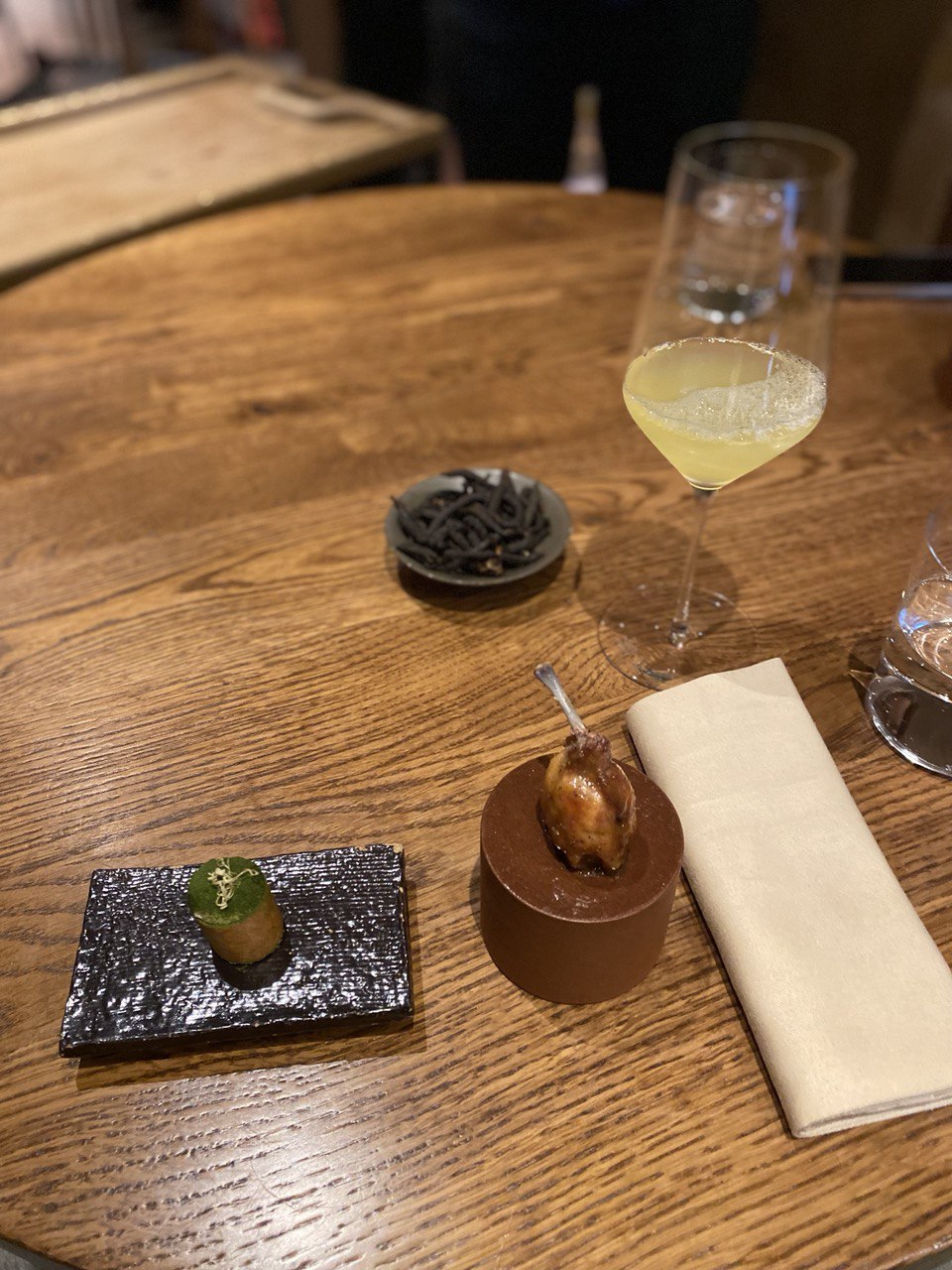
One of my favourite courses was their take on Jollof rice with chives, carrot terrine, and aubergine puree. This is probably a completely vegan dish, but it was exceptionally well-balanced and hearty, as well as its paring of hibiscus cold brew with citrus and pineapple infusion and scotch bonnet.
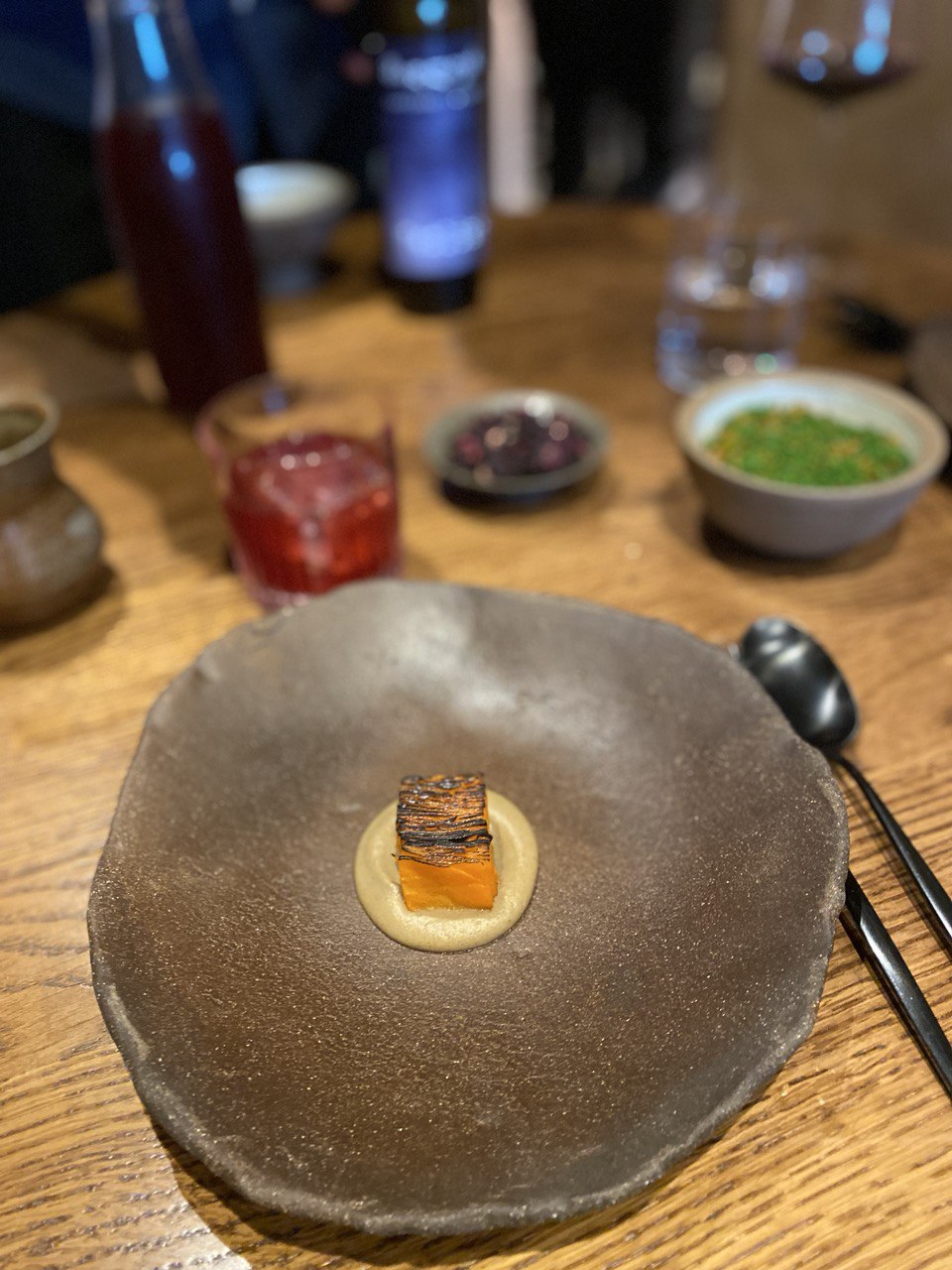
Back home I continued my attempts at making a perfect chicken burger. The first vesion featured a reduced gojuchang glaze, as well as a breading with homemade sourdough breadcrumbs, but didn't really work well enough:

Couldn't complain about it for breakfast though:
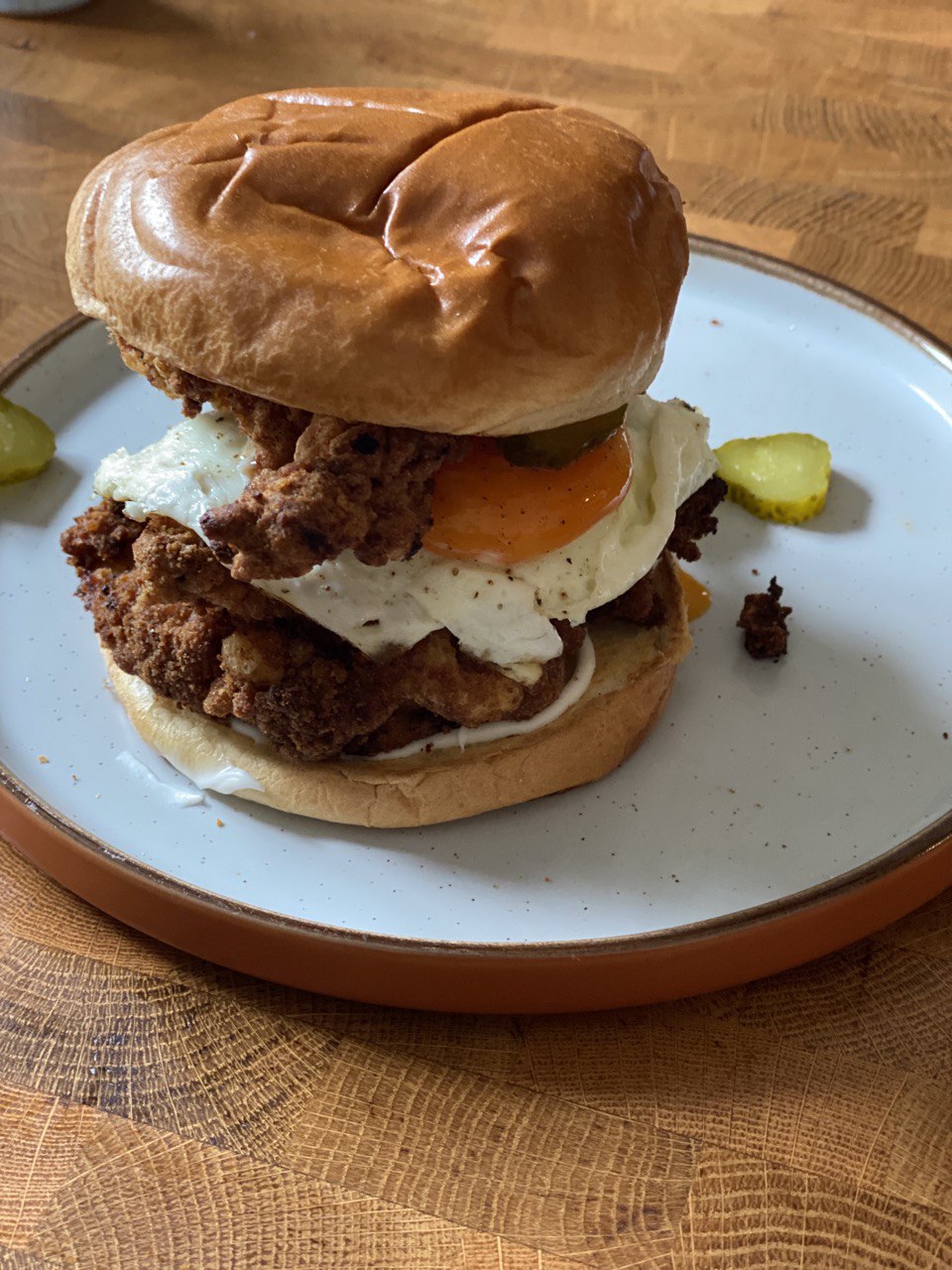
But then I tried to simplify the breading a bit, threw in some MSG, brined the chicken in a pickle liquor and it did some magic:

I've also whipped some homemade mayo with yuzu juice, truffle oil and freshly grated black truffle:
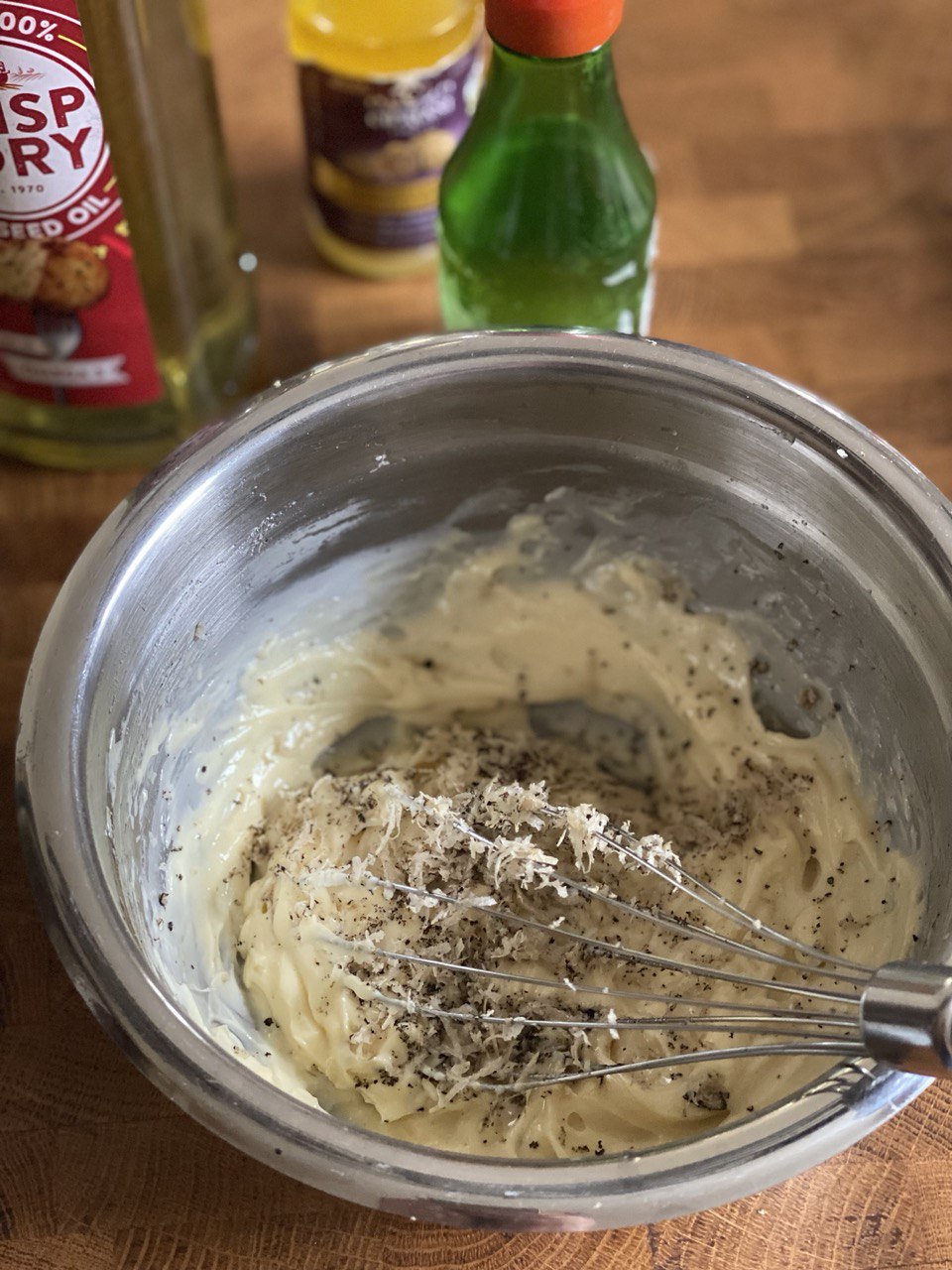
Sadly those burgers disappeared faster than I managed to make a picture of a cut, but the main takeaway is that the brining is probably the single most important step of any deep-fried chicken.

Now onto renting out a truck and sourcing some more truffles, and I am ready to open a pop up. Athough maybe I will come up with a better burger bun too in the meantime.
Things I enjoyed reading ¶
1. How DALL-E 2 Actually Works by Ryan O'Connor ¶
Probably the last time I was so astonished by an artificial system was with the release of GPT-3. DALLE-2 allows you to generate images of various styles based on their description, which pretty much shows how cartoonists and illustrators could become obsolete in less than a decade:
CLIP is trained on hundreds of millions of images and their associated captions, learning how much a given text snippet relates to an image. That is, rather than trying to predict a caption given an image, CLIP instead just learns how related any given caption is to an image. This contrastive rather than predictive objective allows CLIP to learn the link between textual and visual representations of the same abstract object.
This article errs on the technical side (which I enjoy), but if you are not convinced do look up the examples of how it works.
2. ‘It’s a head office for tinkering’: Jony Ive and Marc Newson talk tools by Nick Foulkes ¶
A pretty interesting interview with Jony Ive, the person behind many past design decisions at Apple:
When the basic architecture of the idea was defined, I really struggled with the physical design. It was from that place of struggle that I asked you to help. While it was humbling for me, I think we got to the final design quickly together. We are proud of the work. I always hope to achieve that sense of inevitability, that simplicity where there doesn’t really appear to be a rational alternative.
The article also links to a selection of tools Jony keeps on his table, and there are some unexpected ones (like a Hermes measuring tape).
3. ’Why Am I Not Rich & Famous?’ the Delusion of Our Times by Darius Foroux ¶
An essay on a mismatch between dreams, enforced by the media, and the real world we grow up into. I do not necessarily agree with the author blaming everything on the social media et al, but it's hard to argue with the main idea:
We’re no longer driven by values, morals, loyalty, or family, we’re driven by what the media emphasizes. What’s the overarching theme of all media?
Celebrating the rich and famous. Our culture cares about winning, and that’s the only thing that matters.
There is also a good take on what should we aim for in life if not for money and fame.
4. How Well Can You Kaggle with Just One Hour a Day? by @DSaience ¶
What would happen if you were to spend an hour a day practicing machine learning and try to avoid copy-pasting instincts? And for two months in a row? This is an interesting summary of things that worked and things that didn't:
I was thrilled to see how consistent little time invested each day compounded and helped me move up the board. Although this was a finished contest when I attempted it, I still felt the competitive rush while I participated in it. There were a lot of things I feel I could have done differently...
Personally I would still swear by consistency of doing something for an hour a day rather than for seven hours a week, as such flexibility increases the chances of postponing everything until the last day, and programming for seven hours straight is tough, but I guess whatever works.
5. What Dinner Will Look Like in the Next 100 Years, According to Scientists (and Sci-Fi Authors) by @alex_beggs ¶
A few ideas on the future of cooking (and eating), some of which are baked by scientists, and some are found in books:
Personalized nutrition was the phrase I heard most from food industry experts, like the head of R&D at PepsiCo, which recently launched a sweat patch to tell you when you need more Gatorade (often). What 23andMe did for genetics, we’ll see in the nutrition and gut-health departments. Imagine a wristwatch that pings you when your sodium’s high. Cool! Creepy!
I actually believe that nutrition and similar things will come to the screens way earlier. There are already glucose patches that live sync with Bluetooth, and maybe in a few years Apple Watch will learn how to measure the blood alcohol.
6. The Two Generals Problem by Seth Archer Brown ¶
The title is not helping much, but this is actually a great metaphor for a common programming problem of acknowledgments between services, and there are multiple ways to attempt solving it:
For our solution to work, we have to handle another complication, which is a direct consequence of the issues raised by The Two Generals Problem–exactly once message delivery is impossible over an unreliable network. We can send a message once, and hope that it arrives (but it might not), or we can send a message many times. In that case it may arrive more than once (maybe many more times).
As someone who mostly deals with mobile apps, I rarely have to face these problems (unless it's a part of pentesting exercise), but it's nice to be aware of them nonetheless, especially when there is such a detailed explanation.
7. The Hidden Histories of To-Go Container Art by Anne Ewbank ¶
We mostly throw away to-go containers the moment they reach our tables (or the moment the food disappears), but seems like they have a proper history and differ across the globe:
Takeout containers—especially for pizza, Chinese food, and sushi—have an iconic art and style. Granted, it’s not always the most elegant or politically correct, but some of these designs are now instantly recognizable. So, today, we investigate the origins of the smiling chef of pizza-box fame, the ubiquitous red pagoda of American-Chinese takeout, and the surprising elegance of plastic sushi trays.
Probably next time I get sushi I will pay a bit more attention to boxes it comes in.
8. How to play tabletop RPGs by yourself by Chase Carter ¶
Wherever I'd live, I always had a few tabletop games at home, but never even considered an option to play them alone (to be fair I just played Quake 3 instead). Seems like it's not an issue even for multiplayer RPGs:
Before we talk about the specifics, it’s important to understand that the solo RPG experience can’t be neatly transitioned from your usual group play. You won’t be able to wear the GM hat and player hat simultaneously. Many systems abstract the duties of running the game into dice rolls and random tables, allowing you the freedom to make important decisions and enjoy how they shape the ongoing story. Others shift the focus away from numbers and maths in lieu of an experience akin to a Choose Your Own Adventure book.
Then again, I'd still probably just play Quake 3 instead.
9. Hacks for engineering estimates by @shubroski ¶
This is a really thoughtful overview of everything that's wrong with engineering estimates, especially at early stages of a feature kick-off.
It’s common for people to share confidence levels (high, medium, low) alongside their engineering estimates/commitments. It’s not as common to continuously update those confidence levels as a project progresses.
Updating confidence levels over time is valuable to prompt conversation about risks as they’re discovered.
The only thing missing for me is accounting for other blocking parties. An estimation is rarely a function of a single variable, as it often relies on other people sticking to their estimates, not getting ill, not postponing until the last moment and so on.
10. Robots Are Writing Poetry, and Many People Can’t Tell the Difference by @cstarnino ¶
And as I've already mentioned GPT-3, seems like it has made even more progress over the last few years and now people can't distinguish generated poems from real ones:
The extent to which journalists, academics, and computer developers are genuinely troubled by GPT-3’s believability suggests that AI’s holy-grail goal of passing the Turing test—that is, building a machine that can persuade us it is thinking—might be getting too close for comfort.
I am not that worried about the future of this newsletter yet, but seems like some writers could also question their long-term perspectives.
Things I didn't know last Tuesday ¶
1. Oxygen Candles ¶
There are "candles" that could generate oxygen:
The candle supplied by MineARC Systems burns for approximately 60-90 minutes, producing 2600L of oxygen. This amount can provide approximately 20 hours of breathable air for four people. An oxygen candle cannot have its oxygen production regulated or halted and once ignited; it produces oxygen at a rate of approximately 28 Litres per minute until it is exhausted.

Not sure why I couldn't get one from Amazon, even though they require the operator to be very careful, but that sounds like a neat thing to keep at your space station or submarine.
2. Baker’s Dozen ¶
In Russian "13" is occasionally referred to as the devil's dozen ("чертова дюжина"), so I never linked the baker's dozen to the same number.
Request a dozen eggs from a farmer, a dozen steaks from a butcher, or a dozen pencils from a traveling office supplies salesman, and you will almost certainly receive 12 of your chosen item (counting errors do happen). But a baker’s dozen is commonly understood to mean 13.
Apparently it comes from the Middle ages, when English laws imposed severe punishment for short measure, so to protect themselves bakers would add a small piece of bread to each order to ensure they could not be accused of it.
3. Chelsea Pensioner ¶
I've passed by a fancy private mansion in Chelsea a few times, something that looked like a museum with extra benefits, and that wasn't far from the truth:
A Chelsea Pensioner, or In-Pensioner, is a resident at the Royal Hospital Chelsea, a retirement home and nursing home for former members of the British Army located in Chelsea, London.

This is a very notable uniform here in the UK, but I never knew why.
4. Birthing Furniture ¶
Probably worthy of a separate mention in the articles I've read, but I had no idea people came up with such a different furniture for giving birth over centuries:
The recommendation to give birth while lying down was, at least at first, well intentioned. It was formally introduced in 1598 by the French barber-surgeon Jacques Gillemeau, who claimed reclining was most comfortable and would help induce labor.
Check out the link for photos and examples.
5. Booza ¶
I've mentioned salep quite some time ago, and while I already knew it is used for the stretchy Turkish ice cream, seems like there is a different version that goes heavier on mastic but is as chewy:
Booza is a Middle Eastern frozen dairy dessert made with mastic and sahlab (orchid flour), giving it its distinguished stretchy and chewy texture—much like dondurma.

While salep is probably illegal to export from Turkey, I already have some mastic at home, so that will be probably the next ice cream I make.
6. What Do Actors Actually Smoke In Movies And Shows ¶
I was pretty sure most actors just smoke real cigarettes in movies, especially the older ones, as CGI probably just became good enough for such a delicate task:
These cigarettes look as real as a real cigarette, and so does the smoke that comes out of the mouth after a drag. It even burns like one. But it is not tobacco. The prop cigarettes are filled with herbs such a tea leaves, cloves, rose petals, etc. They are nicotine-free, addictive-free, and tobacco-free.
I guess the fact that they are addictive-free is very convenient, but then it sounds pretty unhealthy anyway.
7. Warabimochi ¶
I was researching ferns in Japan and came across a similar word used to describe fake mochi:
Warabimochi is a wagashi (Japanese confection) made from warabiko (bracken starch) and covered or dipped in kinako (sweet toasted soybean flour). It differs from true mochi made from glutinous rice.
Sounds and looks probably even better than the real ones:

8. Fève ¶
This is not the first time I hear about the king cake (or the French alternative, Galette des Rois), but I never thought there is a dedicated word for something people hide inside:
A fève is a small trinket hidden in a king cake or similar dessert. They may also be known as trinkets or favors. The French word fève translates to 'fava bean', which is what was originally hidden in the cake. Modern fèves can be made out of other materials, such as porcelain or plastic, and can take varied shapes and forms.
There are even large collections of these items, and some people dedicate decades to collect them:
9. Sherlock Holmes (soundtrack) ¶
Hans Zimmer used a broken piano to make the soundtrack sound like something you'd hear in a pub.
At first, Zimmer had his own piano detuned. But he found that it did not accomplish his goal. It simply sounded out of tune. He asked his assistant to locate a broken piano for him. The first piano they located was passed over as it had obviously been loved and cared for. But the second piano they found was the one they used in the production of Sherlock Holmes. Zimmer said "We rented 20th Century Fox’s underground car park one Sunday and did hideous things to a piano."
I don't think I've actually watched the movie till the end, so maybe that's a good reason to give it another try.
10. île flottante ¶
Another beautiful dessert I somehow completely ignored up until now (even though its ingredients are well-known to me if served separately).
A floating island or île flottante is a dessert consisting of meringue floating on crème anglaise (a vanilla custard). The meringue is prepared from whipped egg whites, sugar, and vanilla extract and baked in a bain-marie. The crème anglaise is prepared with the egg yolks, vanilla, and hot milk, briefly cooked.

I am really curious how much of a difference the bain-marie would make to a meringue here: judging by the videos I've found, it maintains the shape but looks way softer than usual.
Book of the week ¶
At some point I joined a few members' clubs and while they call for a story on its own, this weekend I have arrived to a meeting with a friend nearly an hour ahead, so spent some time reading a book randomly picked up from a shelf.
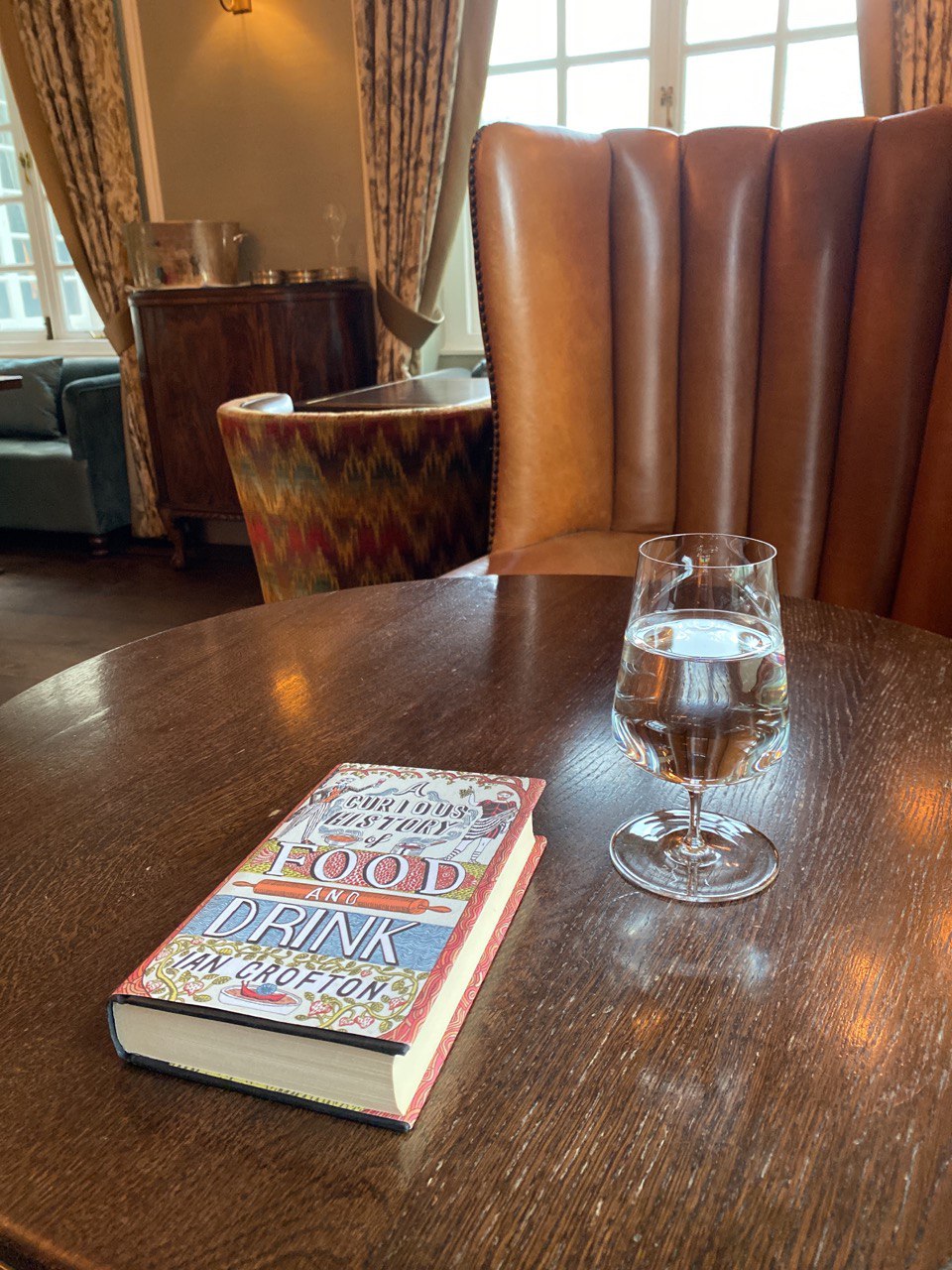
That was a safe bet, as these good folks stock only books on food and drinks (mostly on the latter though), so Ian Crofton's A Curious History of Food and Drink didn't disappoint:
At this early stage in India, the eating of beef—subsequently completely taboo among Hindus—was tolerated, and indeed the Mahabharata mentions Brahmans (members of the priestly caste) sitting down to hearty meals of beef. However, the medical texts warn that, as beef is “heavy, hot, unctuous, and sweet,” it is hard to digest and should only be eaten, with caution, by those who lead physically active lives. Beef broth, however, was regarded as an excellent medicine, especially for those with any sort of wasting disease. The consumption of beef continued at least into the first century AD.
And that's how the whole book is organised. A timeline going from the times before Christ and well into the 21st century, and hundreds of facts worth of this newsletter, but exclusively about food and drink.
I will probably resist the temptation to quote them one by one, but mostly because quite a few of them would make a great conversation starter, so I just want to keep them to myself for now.
And also book shelves in restaurants are heavily underrated.
Thank you and see you in a week! ¶
If you have any questions, or want to suggest a link for the next newsletter, please drop me a message on Twitter or reply to this email.
Cheers! 🍸